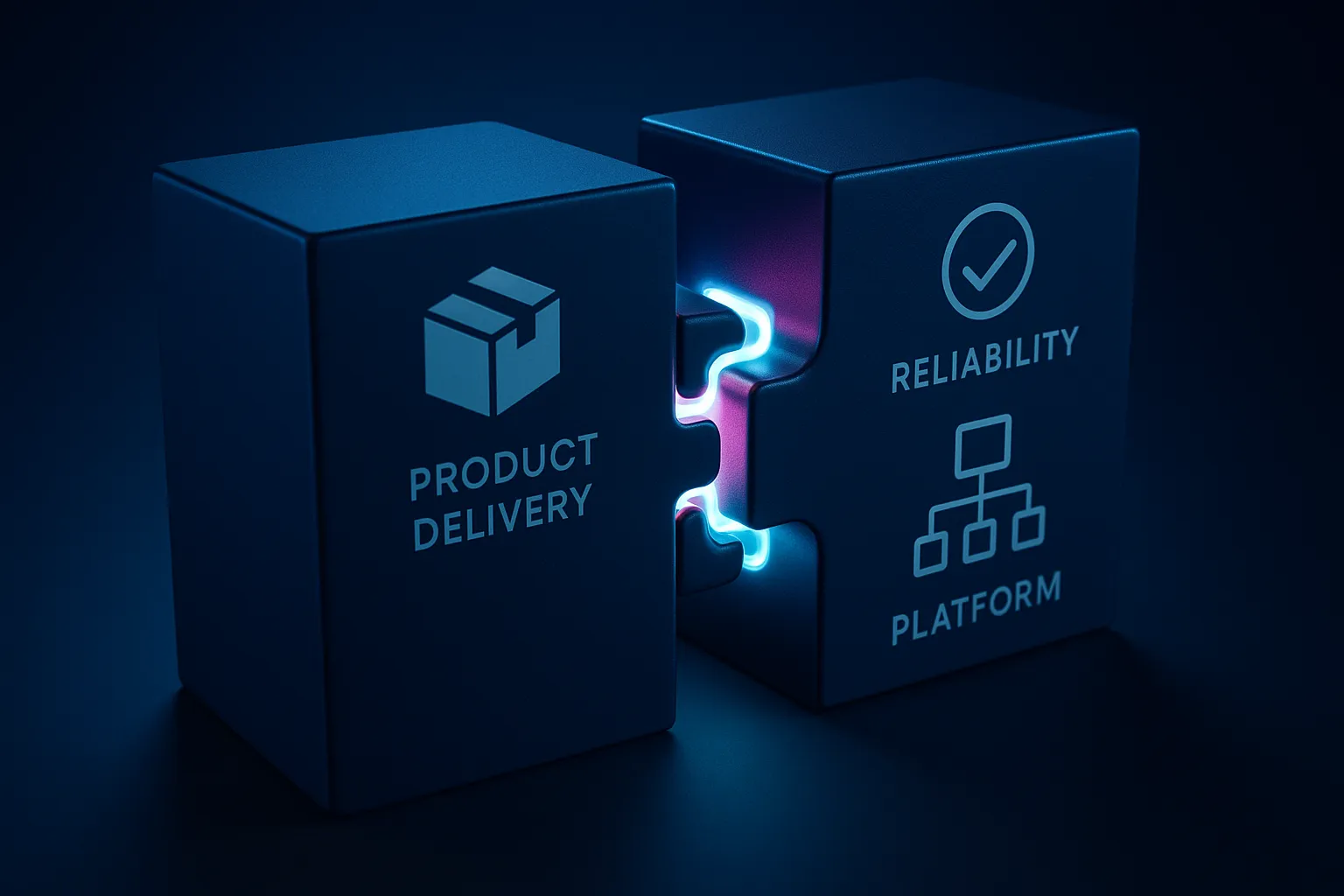This post gives you a decision framework and a way to act. What you will not get here: a tool pitch, a reorg template, or promises of instant results. The focus is on a core decisions you can make now that improve reliability and delivery without adding process for its own sake.
The DevOps and SRE landscape - what you are actually choosing
Leaders often see DevOps, SRE, GitOps, ITIL 4, Agile, and Platform Engineering as competing doctrines. They are not. They are complementary ways of working you can combine to reach the same outcome - speed with safety. Let’s explore them all one by one. This post is necessarily term-heavy, but bear with me - I’ll explain them all.
DevOps (CALMS) in plain English
Key terms:
- CALMS stands for Culture, Automation, Lean, Measurement, Sharing - a simple checklist for good DevOps behaviors.
- DevOps is a culture and set of practices that improve flow from idea to production while keeping services reliable.
DevOps is first a mindset, then a toolbox. It emphasizes small batches, automated delivery, and shared accountability between product and operations. It fits product teams that ship frequently and can standardize on a few pre-defined paths. Watch out for tool-first transformations and blindly following acronyms without changing incentives.
SRE - reliability as a product feature
SRE (Site Reliability Engineering) applies software engineering practice to operations, controlled by SLOs, error budgets, and toil reduction.
SRE adds explicit reliability guardrails. Teams define service level objectives, spend their error budget on change, and pause or slow releases when budgets are exhausted. It shines in high-stakes systems where customer trust, revenue, or safety are on the line. Do not treat SRE as a rebranded ops team - its purpose is to engineer reliability, not accept unlimited manual work.
GitOps - operations through Git
GitOps manages infrastructure and apps declaratively with Git as the single source of truth and automated reconciliation.
GitOps makes change auditable, reversible, and consistent across environments. It excels in multi-service, multi-cluster estates where drift is costly. Pair it with strong review practices and an internal developer platform so teams are not left wiring controllers by hand. Pitfall: treating GitOps as a magic wand while allowing every team to invent its own patterns.
Platform Engineering
Platform Engineering builds an internal developer platform that provides golden paths for building, testing, and running software.
A good platform productizes DevOps: secure defaults, easy self-service, and batteries-included templates. It reduces cognitive load and accelerates compliant delivery. Fit is strongest where you have many teams, recurring reliability or security issues, and duplication in CI/CD stacks. Risk: building a beautiful road no one drives because it ignored developer needs.
ITIL 4 aligned service management
ITIL 4 is a service management framework modernized to support flow, automation, and collaboration with DevOps.
You do not have to choose between governance and speed. Keep change, incident, and problem management - express them as policies in code, automate low-risk approvals, and reserve human review for genuinely risky changes. This pairing is effective in regulated industries that require consistent evidence without ticket bottlenecks.
Agile delivery styles
Agile is a family of delivery methods that prioritize rapid feedback and incremental value.
Scrum time-boxes work into sprints. Kanban limits work in progress to optimize flow. These are delivery cadences, not DevOps substitutes. Pick one to match team context, then let DevOps, SRE, GitOps, and your platform provide the engineering system that makes delivery safe and repeatable.
Practical Questions to Answer
- Which two or three services would truly benefit from explicit SLOs and error budgets this quarter?
- Where is developer friction highest today - provisioning, deployments, or troubleshooting?
- If you had to offer one golden path next month, what would it include by default?
You now have the options. Don’t rush into picking a label yet, let’s examine which business, system, and team factors narrows the solution space first.
Tailor the approach to your context
Key term: Context driver is a business or technical factor that shapes which DevOps/SRE methods will work in your company.
Copying someone else’s model rarely lands. Combine a small set of practices that move outcomes you care about - reliability, speed, and cost - with minimal disruption. Start from your context, not a framework.
The seven context drivers
Start with the customer, then the systems, then the people and budget.
-
Customer journey steps that matter. Which step hurts most if it slows or fails - sign in, search, checkout, trade execution, admission, month-end close? That is where you invest first in reliability and fast recovery.
-
Risk and trust. What is the real cost of a mistake - lost customers, fines, safety issues, brand damage? Higher stakes need clearer rules and proof that controls work. Lower stakes can run with lighter checks.
-
System shape. Are you running one big application or many small services? On one region or several? With data pipelines and vendor systems in the mix? The shape of your systems sets how many paths to production you need and how standardized they should be.
-
Ownership and handoffs. Who owns build, deploy, and run - product teams, a central group, or a mix? If product teams own services, give them a paved road with self-service. If a central group exists, shift from tickets to coaching and guardrails.
-
Everyday workload. How much time goes to pages, manual releases, and keeping environments in sync? If the answer is “a lot,” start by automating the noisy, repeatable work and tightening runbooks so on-call gets calmer.
-
Skills and hiring. Can you staff reliability and platform roles, or do you need to upskill current teams? If hiring is tough, lean on enablement - templates, starter repos, and simple rules in code that teams can follow without specialists in every meeting.
-
Appetite for change and budget. Are you after quick wins this quarter or a bigger redesign over the year? Choose the smallest set of moves that improve one end-to-end outcome - faster delivery, steadier reliability, or lower operating cost - then build on that.
Shortlist by context - practical cues
Key term: Risk-based change means low-risk changes are approved by automated checks, while high-risk changes get human review.
-
If reliability is non-negotiable and you are regulated. Let product teams own their services with SRE guardrails. Keep change, incident, and problem processes - write the rules in code and collect evidence automatically. Routine, low-risk changes flow without meetings; higher-risk changes pause until the service is back on target.
-
If you need speed across many services. Require pull requests (PR) in Git for every application and infrastructure change. Run automated checks on each PR - tests, linting, security scans, and policy rules - before merge. Use an internal platform that gives teams a standard, supported way to build, test, deploy, and run. Ship small changes, make rollback a one-click action, and put security and compliance into the default templates and pipelines so teams are not writing custom scripts for each service.
-
If you have legacy systems. Start by creating shared, standard pipelines for build and release, automate environment setup, and offer common templates. Reduce handoffs, limit work in progress to keep flow steady, and capture infrastructure in code so it is repeatable and auditable.
-
If you depend on data and ML pipelines. Treat pipelines like products with clear goals for freshness and accuracy. Automate promotion between stages, track data quality signals, and apply the same incident routines you expect for customer-facing services.
Two quick examples
-
Fintech payments team. They set clear service level objectives for authorization speed and uptime. A simple rule ran the show - if targets were missed, new releases slowed or paused until the service recovered. Low-risk infrastructure changes were auto-approved after tests passed; higher-risk ones got a quick human check. Results: fewer late-night rollbacks, faster approvals for routine work, and clean audit evidence without extra paperwork.
-
SaaS company with many services. A small platform group introduced one standard way to build, test, deploy, and run. Every change went through a pull request in Git with automated tests, security scans, and policy checks before merge. Common templates replaced custom scripts, and rollback became a one-click action. Outcomes: code reached production faster, paging got quieter, and no reorg was needed.
Quick shortlist exercise
-
Map 3 customer steps where failure hurts and the systems behind them.
-
Pick 2 blockers (risk rules, tool sprawl, manual work, hiring gaps).
-
Choose 1 path for this quarter:
- Reliability first (SRE guardrails, change rules in code, pause when off target);
- Speed at scale (PRs for all changes, one standard pipeline, small changes + easy rollback);
- Stabilize legacy (shared pipelines, automated environments, infrastructure as code).
-
Do 3 moves and watch 2 measures:
- Set 1–2 SLOs with an error budget;
- Ship a default pipeline;
- Automate the noisiest task;
- Track time to production and SLO hit rate.
You’ve just got a shortlist anchored to your context. Now let’s put all pieces together: who owns what, how work moves, and which simple rules keep speed and reliability in balance.
Design a hybrid that works
Most companies do not run one pure approach. Different systems carry different risk. The goal is to set clear ownership and handoffs so teams ship fast while reliability and compliance stay intact.
Three patterns that usually fit
Product teams with SRE guardrails. Product teams build and run their services. A small reliability group coaches them on setting service level objectives, reviews major incidents for learning, and helps choose when to slow or pause releases if a service drifts off target. Ownership stays local while leaders have a clear safety line tied to customer impact.
Platform with pull-requested changes. A platform team offers one supported way to build, test, deploy, and operate. Every app and infrastructure change lands through a pull request with tests, security scans, and policy checks before merge. This replaces fragile custom scripts with repeatable paths and makes rollback simple.
Automated operational control. Instead of more meetings, encode the rules for routine work as code. Examples: auto-approve low-risk releases that meet test and policy checks, block direct changes to production settings outside the pipeline, and require a quick follow-up review after emergency fixes. Evidence is captured as part of the workflow, not in a separate spreadsheet.
The guardrails that make hybrids safe
- Reliability targets and budgets. Give each important service a small set of targets for availability and latency. Treat the allowed miss as a budget. When the budget is used up, shift attention to recovery and slow new change until the trend is healthy again.
- Risk labels for change. Classify changes by blast radius and reversibility. Proven standard changes move automatically. Riskier changes need human eyes and a clear rollback plan.
- Policies as code. Keep rules versioned and testable. Typical policies include who can approve what, which repos can deploy to which environments, and minimum checks required before release.
Roles and Responsibilities
- Product teams operate their services, own dashboards and runbooks, and respond to pages.
- SRE curates the reliability playbook, helps set targets, and partners with teams to remove repeating failures.
- Platform builds the default path to production, provides secure templates, and keeps shared tooling healthy.
- Security and compliance define baseline controls and supply automated checks in the pipeline.
- Engineering leadership resolves trade-offs when delivery speed and reliability pull in different directions.
Keep the platform useful
Treat the platform like a product. Talk to users, watch adoption, and track time to first deploy. Remove steps that do not add value, write short release notes for improvements, and make the golden path the easiest path.
Start With a Pilot
- Pick one critical service and write two targets that matter to customers. Agree on what happens when a target is missed.
- Standardize one path to production for that service: pull request required, tests and security checks run, and a fast rollback.
- Add one policy as code for a common risk, such as blocking manual edits in production or requiring a rollback plan for medium-risk changes.
Ownership and rules should be clear by now. The last step is turning choice into progress - a one-page policy, a small dashboard, and a leadership rhythm that removes blockers.
From model to a policy
You have a working model. Now make it stick. Move just enough to change outcomes, not so much that teams stall. Follow through to pick the right scale of change, capture it on one page, and establish the rhythm that removes blockers instead of adding meetings.
Evolution or Revolution?
- Evolution when teams already ship often and pain is uneven. Keep the org shape, upgrade ways of working in place.
- Revolution when the system fights every change. Make a few bold moves together, then stabilize.
Quick test: if two products can share one path to production and the same reliability rules with few exceptions, evolve. If every team is a snowflake and basics are missing, reset.
Write down your decisions
Your policy should fit on one page and answer five things:
- Outcomes you expect by quarter’s end.
- Owner for each outcome.
- Start/stop behaviors to get there.
- Guardrails you will not cross (customer promises, risk limits).
- Review date when you will adjust or expand.
If it does not fit on one page, you are planning activities, not writing policy.
Set three working agreements
- Reliability first response. When a key service slips below its target, new releases slow or pause until it recovers - no exceptions.
- One path to production. Changes follow the same steps with the same checks. Rollback is simple and practiced.
- On-call hygiene. Clear rotations, quiet hours respected, runbooks live next to code, and each incident produces one improvement.
Keep score with a tiny dashboard
Pick a handful of measures leaders will actually read:
- Lead time - how long a change takes to reach production.
- Deployment frequency - how often you ship.
- Change fallout - how often a release causes trouble.
- Time to recover - how quickly you fix customer-impacting issues.
Track trends weekly. If speed increasing along with failures, slow down and fix quality. If recovery improves while speed is flat, you are stabilizing. If both improve, scale the approach.
Leadership rhythm that removes blockers
Hold a short weekly review for the few services that matter most. Look at the dashboard, pick one blocker to remove, name an owner, and confirm the next check-in. Run a monthly cross-product review to surface shared platform work. Publish a brief note on what changed and what is next so teams are not guessing.
Leadership commitments this week
- Name an owner for the standard path to production and give them authority to remove duplicate steps.
- Publish the reliability rule you will use when a service misses its target, so teams know what happens before it happens.
- Retire one approval that no longer adds value and replace it with an automated check.
If this post did its job, you now have enough clarity to pick a path, test it in your environment, and grow what works. Keep the policy short, the rules clear, and the feedback fast.
You do not need a grand redesign to get better results. Fit beats fashion. Choose a small set of practices that match your business, design clear ownership and handoffs, and run them with a simple cadence.



